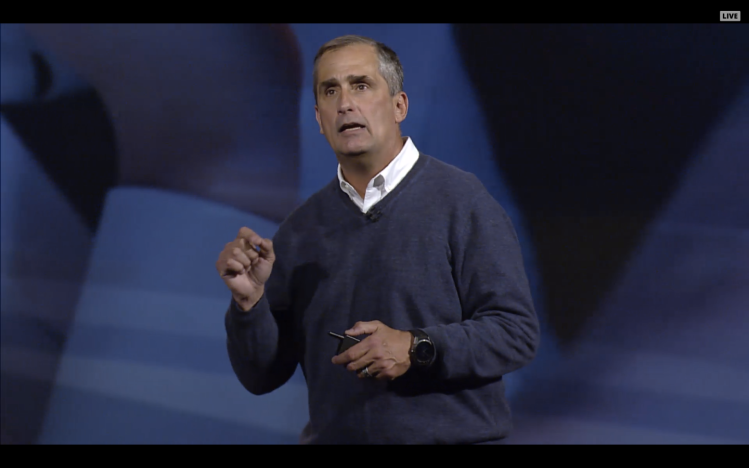Riding high on the launch of its code-named Skylake processors, Intel reported earnings today that beat expectations for the fourth quarter.
The world’s biggest chip maker reported earnings of $3.6 billion, or 74 cents per share, on revenue of $14.9 billion. Analysts had expected earnings per share of 63 cents on revenue of $14.8 billion.
“Our results for the fourth quarter marked a strong finish to the year and were consistent with expectations,” said Brian Krzanich, Intel CEO, in a statement. “Our 2015 results demonstrate that Intel is evolving and
our strategy is working. This year, we’ll continue to drive growth by powering the infrastructure for an increasingly smart and connected world.”
In after-hours trading, Intel’s stock is falling slightly to $31.79 a share, down 95 cents. Overall, Intel’s stock is valued at around $154 billion.
During the fourth quarter, Intel ramped up sales of its 14-nanometer Skylake processors, formally known as 6th-generation Intel Core processors. Those chips, optimized for Microsoft’s Windows 10, are targeted at everything from tablets to high-end gaming PCs.
Intel is also strong with its dominance in the server chip market, which generates around $14 billion a year for the company, according to Gartner. And the company is preparing a formal launch of its Curie processor, a sub-$10 chip that is targeted at the Internet of Things, or making everyday objects smart and connected.
At the 2016 International CES, Krzanich touted ever-growing uses for technology — including computing, communications, and sensors — in a wider variety of applications, from drones to robots to home security devices to BMX stunt bikes. PC makers touted 2-in-1 convertible laptops/tablets, all-in-one desktop PCs, and gaming machines. Virtual reality headsets are expected to increase demand for high-end computers, as they demand about seven times the graphics processing power of standard PC games, according to Nvidia.
In the quarter, the client computing group reported fourth quarter revenue of $8.8 billion, up 3 percent from the prior quarter and down 1 percent from a year ago. Data center revenue was $4.3 billion, up 4 percent sequentially and up 5 percent from a year ago. Internet of Things group revenue was $625 million, up 8 percent sequentially and up 6 percent from a year ago. Software and services were $543 million, down 2 percent sequentially and down 3 percent year over year. Non-volatile memory revenue was flat sequentially, up 10 percent year over year.
A year ago, Intel reported net income of $3.7 billion, or 74 cents a share, on revenues of $14.7 billion for the fourth quarter.
In the previous third quarter, Intel beat profit expectations with $3.1 billion in profit, or 64 cents a share, on $14.5 billion in revenue. In October, Intel predicted revenue growth of about 2 percent for the fourth quarter, compared to the third quarter. It predicted revenues would be $14.8 billion, plus or minus $500 million, in the fourth quarter. Gross profit margins were expected to be 62 percent, down a point from the third quarter.
During the Skylake launch, Intel said there are more than 500 million computers in use that are five years old or more. They are slow to wake up, their batteries don’t last long, and they can’t take advantage of a lot of new software. Compared to five-year-old PCs, Intel said the Skylake graphics are 30 times faster. Laptops using the chips are half as thick and half the weight of the older ones. Laptop batteries can pretty much last all day now.
During the fourth quarter, Intel completed its $16.7 billion acquisition of Altera.
For the full year, Intel reported net income of $11.4 billion, or $2.33 a share, on revenue of $55.4 billion. Intel has $19 billion in cash from operations.
Looking ahead, Intel said that non-GAAP revenue is expected to be $14.1 billion in the first quarter, with a gross margin target of 62 percent. For 2016, Intel’s research and development spending will be $21.3 billion.
“As Intel has repeated for many quarters in 2014 and 2015, PCs were down and datacenter and IoT were up,” said Patrick Moorhead, analyst at Moor Insights & Strategy. “This has been a consistent theme for the last few years except for a few quarters where commercial PCs actually rose. I do think 2016 will be much better for PCs and PC-based platforms like convertibles and 2-in-1s. Commercial buyers will start to make the transition off of Windows 7 platforms onto a much more secure Windows 10. Intel’s SkyLake, with its hardware-based security, rounds out what businesses will be looking for. The other SkyLake benefit is that commercial PCs, as we saw at CES, can be just as thin and light with 10-hour battery life as consumer PCs. That makes a huge difference to businesses where millennials have increased numbers and more and more employees consider a coffee shop their office.”
VentureBeat's mission is to be a digital town square for technical decision-makers to gain knowledge about transformative enterprise technology and transact. Learn More


